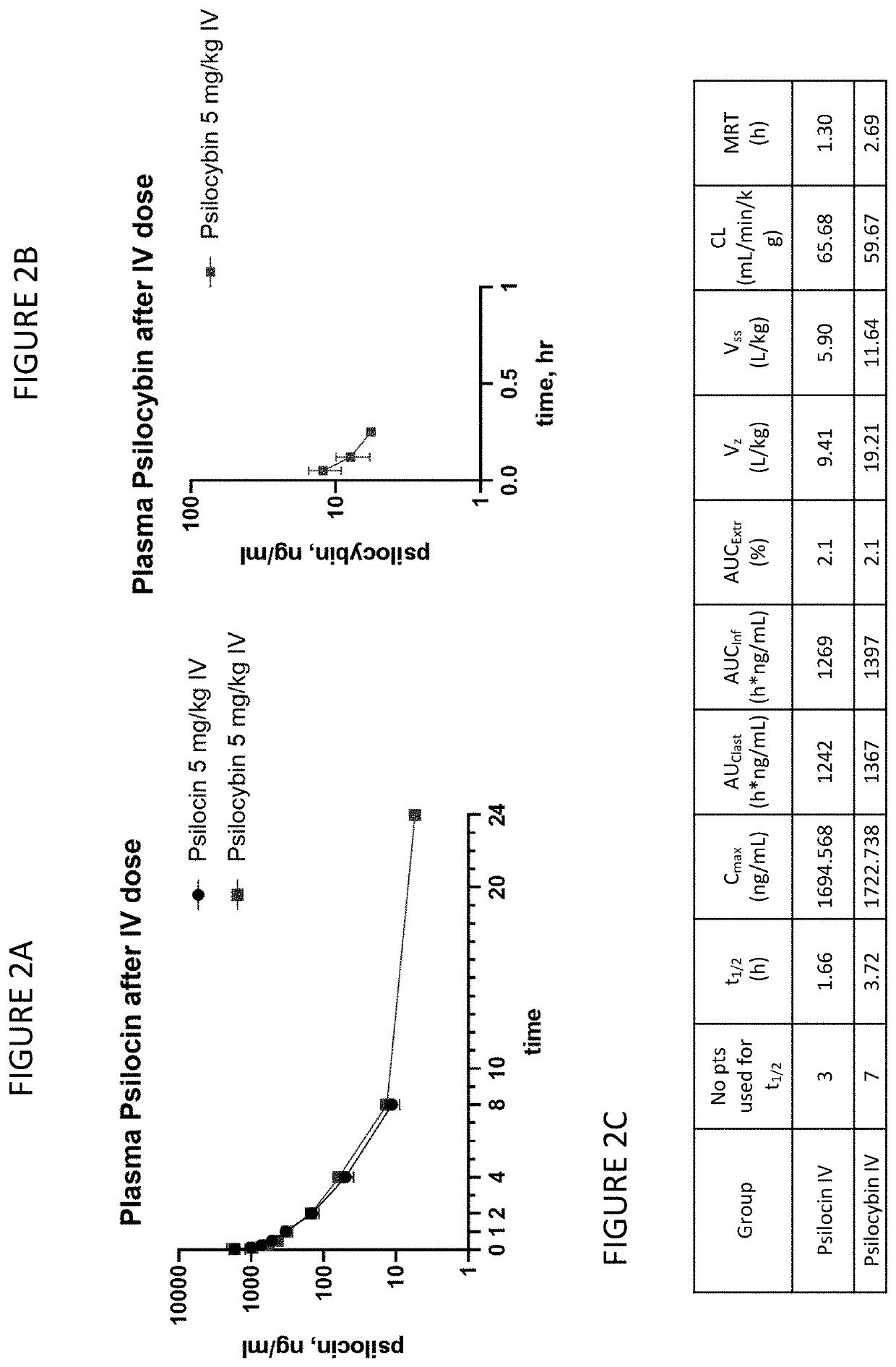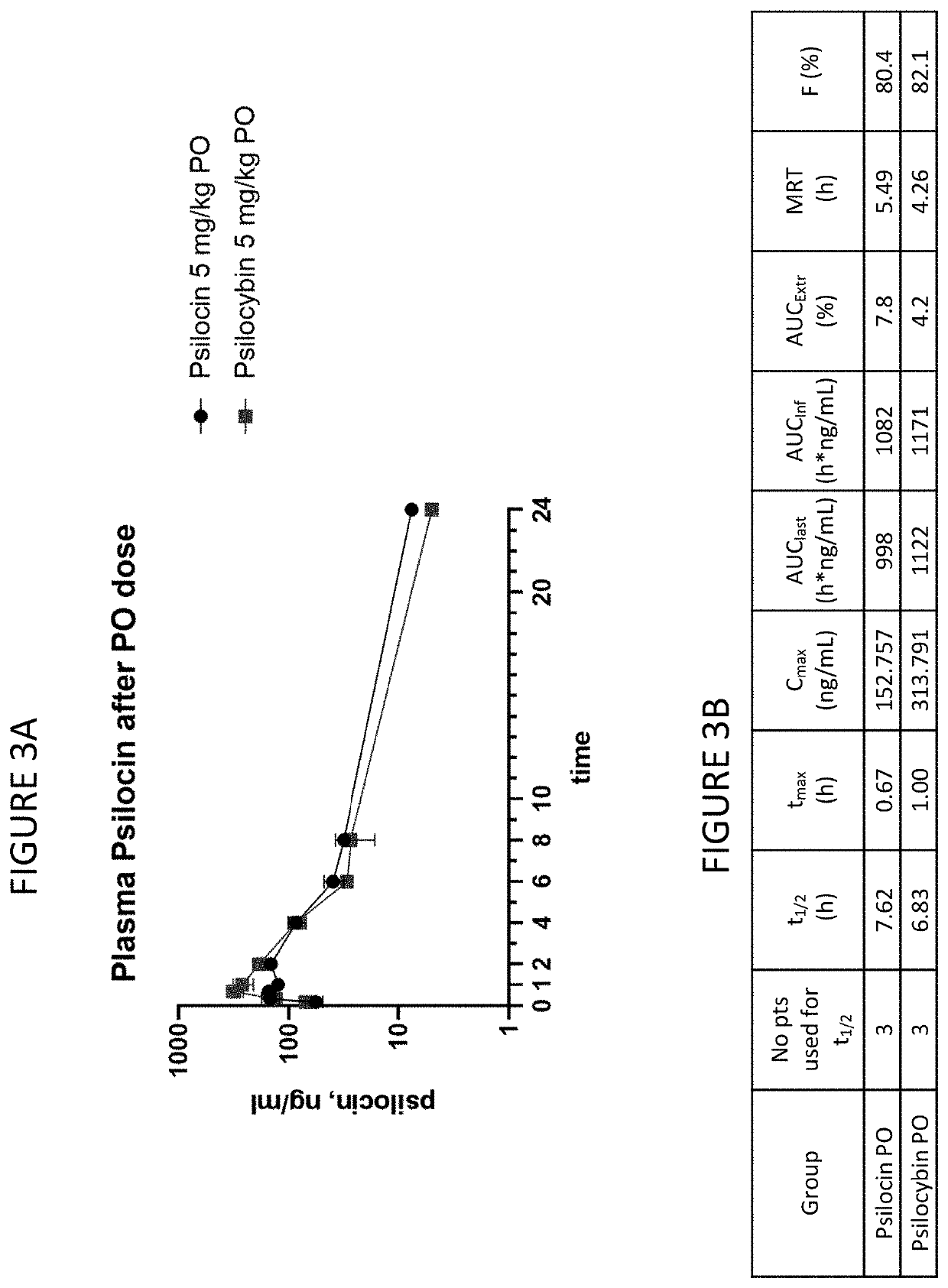Formulations of psilocin that have enhanced stability
a technology of psilocybin and stability, which is applied in the field of psilocybin compositions, can solve the problems of poor product yield, uncertain scalability of the synthetic process to commercial scale, and difficult and costly manufacture of psilocybin, and achieve the effect of enhancing stability
- Summary
- Abstract
- Description
- Claims
- Application Information
AI Technical Summary
Benefits of technology
Problems solved by technology
Method used
Image
Examples
example 1
PK Evaluation of Psilocin and Psilocybin After IV and PO Administration in Rats
[0075]Study Design
[0076]The study design is shown in FIGS. 1A and 1B. The study was conducted in male / female CD rats. Test articles were formulated fresh in PBS. Psilocin and Psilocybin were administered IV and PO. Plasma samples were analyzed for psilocin and psilocybin (group 2).
[0077]FIGS. 2A-2C show PK characteristics of psilocin and psilocybin after IV dosing. FIGS. 3A-3B show PK characteristics of psilocin and psilocybin after PO dosing. FIGS. 4A-4B show psilocin and psilocybin after IV and PO dose. FIG. 5 shows dosing solution analyses.
[0078]Conclusions
[0079]IV administration of psilocin (free base) and psilocybin results in almost identical PK values, including Cmax and AUC and Cl. After IV administration, psilocybin is detectable in plasma for 15 minutes. PO administration of psilocin and psilocybin results in similar PK values, including tmax, t1 / 2, AUC and bioavailability. Measured Cmax after a...
example 2
Analytical Characterization of a Psilocin Tartrate Sample
[0080]One sample of psilocin tartrate (lot 16782-15C) was submitted for optical microscopy (OM), X-ray powder diffraction (XRPD), differential scanning calorimetry (DSC), thermogravimetric analysis (TGA), dynamic vapor sorption / desorption (DVS), and 1H NMR spectroscopy. The chemical structure of psilocin is displayed in FIG. 6. The data in this EXAMPLE shows that psilocin tartrate is a stable crystalline solid.
[0081]Results
[0082]FIGS. 7A-7F show the OM images for psilocin tartrate lot 16782-15C. The sample contains particles that are agglomerates in various shapes. The agglomerates range in length from ˜20 to 50 micrometers. Images of the agglomerates that were obtained with crossed polars in place show birefringence with extinction indicating that these particles are crystalline.
[0083]The acquired XRPD patterns for psilocin tartrate, initial material and post DVS analysis, are presented in FIGS. 8 and 9, respectively. Based u...
example 3
[0103]In this EXAMPLE, the data shows that making a salt is a viable strategy to prepare stable psilocin solution formulations; this can be used to prepare solid psilocin formulations with enhanced shelf life, and can lead to improved PK properties upon human dosing. The limited stability of psilocin free base under a variety of stress conditions is shown in the chart in FIG. 20. HPLC data in FIG. 21 shows the improved stability of psilocin tartrate salt compared to the free base in solution. A salt screen using solutions in ethanol is summarized in TABLE 5. TABLE 5 shows that not all acids lead to stable salt formation under the same conditions.
TABLE 5Vial #AcidResults at 18 ha, bResult at 6 days1AdipicV↑C2Ascorbic0C + solid3t-CinnamicPNC4FumaricFc0 + X5GlycolicFc↑C6DL-LacticFc↑C7Maleic0↑C8MalonicFc↑C9Mandelic0NC10MethanesulfonicNCNC11Oxalic00 + X12Salicylic0↑C13SuccinicFc↑C14L-Tartaric0d0 + X15p-ToluenesulfonicNCNC16ControlPfNCTABLE 5 key:a T0; after storage overnight at RT (Ar; l...
PUM
| Property | Measurement | Unit |
|---|---|---|
| Stability | aaaaa | aaaaa |
Abstract
Description
Claims
Application Information
 Login to View More
Login to View More - R&D
- Intellectual Property
- Life Sciences
- Materials
- Tech Scout
- Unparalleled Data Quality
- Higher Quality Content
- 60% Fewer Hallucinations
Browse by: Latest US Patents, China's latest patents, Technical Efficacy Thesaurus, Application Domain, Technology Topic, Popular Technical Reports.
© 2025 PatSnap. All rights reserved.Legal|Privacy policy|Modern Slavery Act Transparency Statement|Sitemap|About US| Contact US: help@patsnap.com



